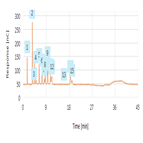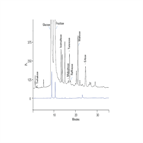Find methods for your needs
Refine by Feature
Displaying 1-5 of 12 results for Tag: Honey
Pesticide residues screening analysis in tea and honey using a Q Exactive Focus High-Resolution Mass Spectrometer
Instrument Type: LCMSMSWe present a multi-residue instrumental method that can be applied for high-throughput screening and semi-quantitation of pesticide residues in food matrices at or below the current legislative requirements. A high-resolution, accurate-mass mass spectrometer operated in Full Scan – Variable Data-Independent Analysis (FS-vDIA)* mode provided an option for full spectrum filtering, retrospective analysis, and multi-parameter-based compound identification. The method was validated for 328 target pesticides, with an option for the future extension to a larger number. (*vDIA not available in US.)
LC-MS/MS analysis of polar pesticides in honey with QuPPe extraction
Instrument Type: LCMSMSWe present a sensitive, robust, fast method to determine and quantify residues of polar pesticides in food samples in complex matrices at required regulatory levels. The Thermo Scientific UltiMate 3400 RSLC system is used in combination with a Thermo Scientific TSQ Quantiva triple quadrupole mass spectrometer to analyze QuPPe method extracts. The robustness of the system allows uninterrupted analysis of up to 500 honey samples and easy cleaning of the ion introduction system.
AN1158: HPAE-PAD Determination of Carbohydrates in Honey to Evaluate Samples for Quality and Adulteration
Instrument Type: ICWe developed a HPAE-PAD method to assay fructose, glucose, and to measure the entire profile of di- and trisaccharides in honey. The separation was achieved on the CarboPac™ PA210-4μm column. Carbohydrate detection was by PAD with a gold working electrode and therefore no sample derivatization was required. In this work, honey sugars of 12 honey samples have been characterized and quantitated by HPAE-PAD. In addition, HPAE-PAD profiling was demonstrated as a method to study the adulteration of honey samples with commercial sugar syrups. An ICS-6000 can be used for this application.
CAN123: Sugars in Honey Using HPAE-PAD: What Is the Best Column?
Instrument Type: ICHoney is defined by the Codex Alimentarius as the natural, sweet substance produced by honey bees from the nectar of plants or from secretions of living parts of plants or excretions of plant sucking insects on the living parts of plants, which the bees collect, transform by combining with specific substances of their own, deposit, dehydrate, store and leave in the honeycomb to ripen and mature. High-performance anion-exchange chromatography with pulsed amperometric detection is commonly used to determine the carbohydrates in honey. This document evaluates CarboPac columns for that purpose.
Advances in Automation of Food-related Analysis and Screening
Instrument Type: LCMSMSWorldwide food safety concerns have risen dramatically as the number of food contamination incidents and product recalls has increased. Every food analysis starts with sample preparation, which is widely accepted as one of the most critical steps of LC/MS. Increased demand for higher throughput, accuracy and lower matrix interference from food analysis laboratories has made sample preparation the largest bottleneck. Turbulent flow chromatography technology can eliminate the need for lengthy offline sample preparation steps, thereby eliminating these disadvantages.





